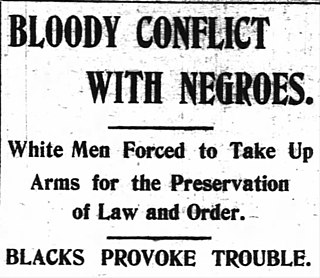Interpretation
This article possibly contains original research .(February 2022) |
Several elements in the story allude to the American Civil Rights Movement of the 1950s and early 1960s. The character Big Jim C., for example, is almost certainly a personification of the so-called Jim Crow laws that enforced racial segregation in the South. Many of these laws remained in effect until the passage of the Civil Rights Act in 1964 and the Voting Rights Act in 1965. When Jesse claims that the blacks "had this line you know, to register", the implication is that they wanted to register to vote and therefore "wouldn't stay where [Jim Crow] wanted them"—i.e., lacking any political or economic agency.
"Jim C." could more specifically (or in addition) refer to Jim Clark, sheriff of Dallas County, Alabama from 1955 to 1966. Clark is widely remembered as a racist who employed violent methods (such as cattle prods) against Civil Rights protesters.
The lynching at the end of the story is a reference to the Lynching of Jesse Washington, in Waco Texas on May 15, 1916. [1] [ circular reference ]
Perhaps the most notable formal aspect of the story is Baldwin's decision to focalize it through the point-of-view of a white police officer. Jesse does not seem to possess a conventional character arc in which he changes in any significant way throughout the story. By the end he appears to copulate with his wife without gaining a deeper understanding of himself or overcoming his racism. The reasons for this may be complex. Baldwin himself was black, and during a 1965 debate with conservative intellectual William F. Buckley Jr., he said the following about whites in the American South:
[W]hat happens to the poor white man’s, the poor white woman’s, mind? It is this: they have been raised to believe, and by now they helplessly believe, that no matter how terrible some of their lives may be and no matter what disaster overtakes them, there is one consolation like a heavenly revelation—at least they are not black. I suggest that of all the terrible things that could happen to a human being that is one of the worst. I suggest that what has happened to the white Southerner is in some ways much worse than what has happened to the Negroes there. [2]
This is a controversial statement, but it centers on the idea that the relationship of oppression is perhaps more dehumanizing to the oppressor than to the oppressed. As such, Baldwin suggests that while Southern blacks may have had their bodies enslaved, Southern whites have had their minds enslaved by white supremacy.
A psychoanalytic reading of the narrative structure suggests that Jesse's racism is not only irrational, but the result of repression. The story begins with a symptom: namely Jesse's inability to achieve an erection. He does not comprehend the cause of this phenomenon, and so "works through" a series of associated memories, each time implicitly linking sexuality and violence (e.g., feeling his penis "violently stiffen" upon beating the young black man). What Freud would call the "primal scene"—i.e., a traumatizing event in the child's early psychosexual development—is recovered at the end when Jesse remembers having attended the lynching. Eight-year-old Jesse even fixates on the black man's penis:
The man with the knife took the nigger's privates in his hand, one hand, still smiling, as though he were weighing them. In the cradle of the one white hand, the nigger's privates seemed as remote as meat being weighed in the scales; but seemed heavier, too, much heavier, and Jesse felt his scrotum tighten; and huge, huge, much bigger than his father's, flaccid, hairless, the largest thing he had ever seen till then, and the blackest.
Jesse's racism could thus be interpreted as the result of a psychological trauma, which helps to explain why, upon finally returning to the "present", he fantasizes about being black in order to perform sexually with his wife. Much like how the Oedipal father figure represents the threat of castration, the stereotype of black men's sexual prowess—figuring in the description of the man's penis being "much bigger than his father's"—informs both Jesse's fear of empowering blacks as well as his perverse desire to be black.
As such, "Going to Meet the Man" suggests that Jesse's racism is so deep-seated that not only does it structure his political worldview, but his entire personality. This type of racism is difficult to overcome, and it is in this way that Baldwin dramatizes the idea that what has happened to Southern whites is actually worse than what has happened to Southern blacks. In the same debate with William F. Buckley Jr., in fact, Baldwin claims that "[t]he white South African or Mississippi sharecropper or Alabama sheriff has at bottom a system of reality which compels them really to believe when they face the Negro that this woman, this man, this child must be insane to attack the system to which he owes his entire identity". [3] We can see this notion operative in Jesse's inability to understand why black folks would want to upset the social order, as well as in his outright hostility towards any challenge to white male dominance. In this respect, despite the horrible things he does, Jesse can be interpreted as a tragic figure—a victim of the very racist ideology he perpetuates.










